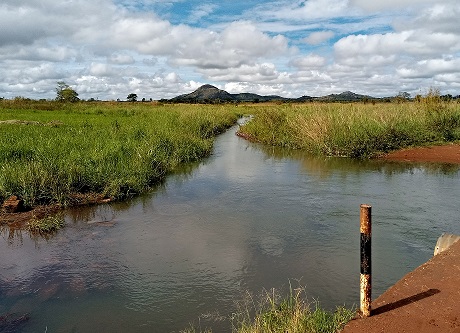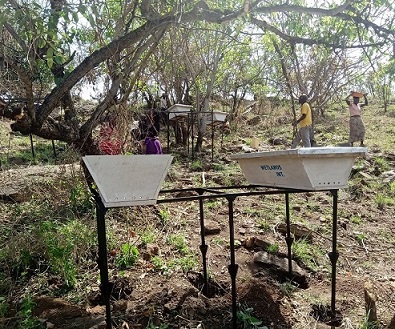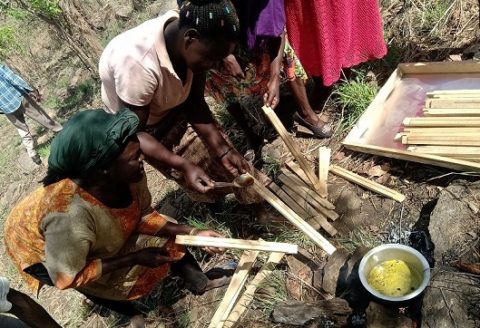In the arid north of Uganda, Doreen Acheng, 29, works in her small farm hoping to improve her livelihood through different ventures. A mother of six, she grows sorghum, beans, cassava and sunflower in Alerek Sub County, Abim District. In the past few years, life has been changing rather too rapidly for comfort and, like many of her village folk, she is particularly alarmed by the unpredictable weather and its impact.
Last October, Acheng together with 32 smallholder farmers attended a meeting held by Wetlands International to assess the level of beekeeping and tree planting in the area as part of the Agago Water Catchment Restoration Initiative. The objective was to strengthen practical interventions geared at restoring the highly degrading semi-arid lands of the Karamoja, an area once endowed with lush, virgin bushland and rich wetlands.

One of the catchments that form part of the River Nile Basin
This Initiative aims to contribute to this community’s economic empowerment and to build resilience by developing ecologically viable value chains. Commercial beekeeping was identified as one of the ventures that would increase household incomes and food security in addition to conserving the dwindling wetlands associated with Upper Agago sub-catchment. The farmers are expected to contribute to sustainable conservation and management of Loyoroit, Ondongi and Angaro micro-catchments.
To realise this objective, Wetlands International Eastern Africa is supporting the 33 farmers to develop viable, market-oriented and profitable small-scale honey value chains. These farmers are expected to contribute to sustainable conservation and management of Loyoroit, Odongi and Angaro micro-catchments which cover 611 square kilometres. Organised in three beekeeping clusters according to their sub-counties – Alerek, Abim and Lotuke – the farmers were equipped this January with a total of 330 Kenya Top Bar (KTB) hives and 330 metallic stands.
From past studies undertaken in the area, it had been established that beekeeping and honey production could flourish through proper training, availability and provision of materials and access to wider markets. Beekeeping in Karamoja has been a tradition and honey from the sub-region has been ranked among the best in the Horn of Africa. Honey has been part and parcel of the nutrition and medicine for the Karamoja: they use it to treat coughs and wounds, as a food preservative and ingredient in many herbal remedies.
During the assessment meeting last October, Acheng revealed that she had three local beehives and two KTB hives that were colonised and sited in trees high up the neighbouring Agonga hills. The hives were neither properly sited nor did the family have protective gear and harvesting kits such as buckets, smokers and knives.
In the honey harvest season between January and March, her husband would melt into the night carrying hot coal and fresh shrubs to light up and smoke out the bees from the hives. Once the bees abandoned the hive, he would then pick out the combs by hand. Having no protective gear, he was forced to endure some inevitable bee stings.
Acheng would then prepare the honey to sell to the local community and use the proceeds to buy food, clothing and other household items for her family. This supplemented their income as ofttimes their crop failed due to the unpredictable nature of rain. Honey production, on the other hand, looked promising as an additional off-farm activity that was not heavily rain-reliant since bees forage throughout the land, bringing in nectar and pollen from many native trees and shrubs dotting the region.

Doreen Acheng, far right, together with her family haul materials for installing beehives in their farm
Like other participants, Acheng exhibited passion and commitment during the assessment visits to the villages where individuals showcased their beehives – traditional or modern, colonised or not – and shared their own stories, fears and aspirations. Last December’s training provided much-needed commercial orientation to the beneficiaries on beekeeping management, benefits of beekeeping to the pollination of crops and ecosystems, dealing with bee stings, use of modern beekeeping inputs, harvesting quality honey and market access.
When Acheng’s cluster – Alerek Beekeeping Cluster – received 110 baited KTB hives and 110 metallic stands in early January, she was exuberant. Unanimously, the cluster members agreed to use her farm as a demonstration field to practice how to site the hives using their newly acquired skills and materials. As part of their input on installing hives in their farms, each member contributed cement, stones, building sand, water and labour.

Abim cluster members baiting the top bars with beeswax during the demo exercise
Acheng unreservedly worked and led by example: enlisting her husband, children and brother-in-law to ferry the hives up the hills, dig holes, prepare the stands, bait the top bars, prepare concrete materials, fasten the hives with wires onto the stands and apply burnt oil on the stands to prevent insects and rodents from accessing the hives once colonised. A few challenges were encountered such as hive siting in the hills as they were manually hauled and setting up levelled stands owing to the rugged terrain.
Following the demo exercises, each member received their starter package and the apiculture experts worked with them to install the hives immediately to avoid past problems where, under other projects, beneficiaries received hives and kept them in their houses; and in some cases, hanging them very high in the tree branches. The actual hiving exercise assisted in gaining experience and building confidence while the bee champions like Mathias Abokolam – also a promising agro-forester – under the Community Tree Planting will mentor and coach members of their clusters for better outcomes.

Abim cluster after successfully siting hives in one of their farms
Field reports from Lotuke indicate the rate of hive colonisation was as high as 40-50% within a period of three to four weeks. Some members hives were already 90% colonised. A monthly follow-up is necessary to support those beneficiaries whose hive occupancy rate is still low.
Agago Water Catchment Restoration Initiative is part of the three-year Ecosystem-based Disaster Risk Reduction (Eco-DRR) project that uses an Integrated Risk Management (IRM) approach. It involves ecosystem management and restoration such as the development of management plans, climate change adaptation and mitigation, and disaster risk reduction while mainstreaming gender in all its activities. Awarded by the European Commission to the UN Environment Programme (UNEP) in collaboration with Partners for Resilience (PfR) represented by the Netherlands Red Cross (NLRC), it focuses on scaling-up Eco-DRR interventions.
